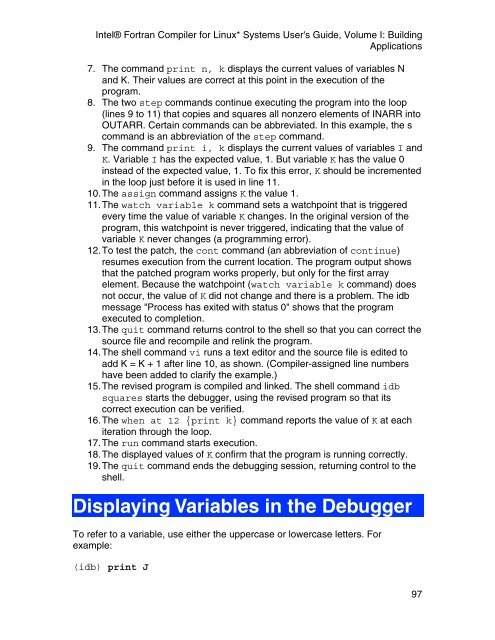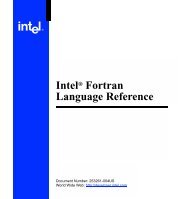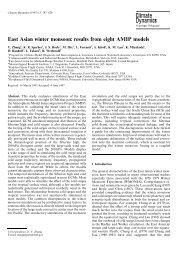Intel(R) Fortran Compiler for Linux* Systems User's Guide Volume I ...
Intel(R) Fortran Compiler for Linux* Systems User's Guide Volume I ...
Intel(R) Fortran Compiler for Linux* Systems User's Guide Volume I ...
You also want an ePaper? Increase the reach of your titles
YUMPU automatically turns print PDFs into web optimized ePapers that Google loves.
<strong>Intel</strong>® <strong>Fortran</strong> <strong>Compiler</strong> <strong>for</strong> <strong>Linux*</strong> <strong>Systems</strong> <strong>User's</strong> <strong>Guide</strong>, <strong>Volume</strong> I: Building<br />
Applications<br />
7. The command print n, k displays the current values of variables N<br />
and K. Their values are correct at this point in the execution of the<br />
program.<br />
8. The two step commands continue executing the program into the loop<br />
(lines 9 to 11) that copies and squares all nonzero elements of INARR into<br />
OUTARR. Certain commands can be abbreviated. In this example, the s<br />
command is an abbreviation of the step command.<br />
9. The command print i, k displays the current values of variables I and<br />
K. Variable I has the expected value, 1. But variable K has the value 0<br />
instead of the expected value, 1. To fix this error, K should be incremented<br />
in the loop just be<strong>for</strong>e it is used in line 11.<br />
10. The assign command assigns K the value 1.<br />
11. The watch variable k command sets a watchpoint that is triggered<br />
every time the value of variable K changes. In the original version of the<br />
program, this watchpoint is never triggered, indicating that the value of<br />
variable K never changes (a programming error).<br />
12. To test the patch, the cont command (an abbreviation of continue)<br />
resumes execution from the current location. The program output shows<br />
that the patched program works properly, but only <strong>for</strong> the first array<br />
element. Because the watchpoint (watch variable k command) does<br />
not occur, the value of K did not change and there is a problem. The idb<br />
message "Process has exited with status 0" shows that the program<br />
executed to completion.<br />
13. The quit command returns control to the shell so that you can correct the<br />
source file and recompile and relink the program.<br />
14. The shell command vi runs a text editor and the source file is edited to<br />
add K = K + 1 after line 10, as shown. (<strong>Compiler</strong>-assigned line numbers<br />
have been added to clarify the example.)<br />
15. The revised program is compiled and linked. The shell command idb<br />
squares starts the debugger, using the revised program so that its<br />
correct execution can be verified.<br />
16. The when at 12 {print k} command reports the value of K at each<br />
iteration through the loop.<br />
17. The run command starts execution.<br />
18. The displayed values of K confirm that the program is running correctly.<br />
19. The quit command ends the debugging session, returning control to the<br />
shell.<br />
Displaying Variables in the Debugger<br />
To refer to a variable, use either the uppercase or lowercase letters. For<br />
example:<br />
(idb) print J<br />
97













